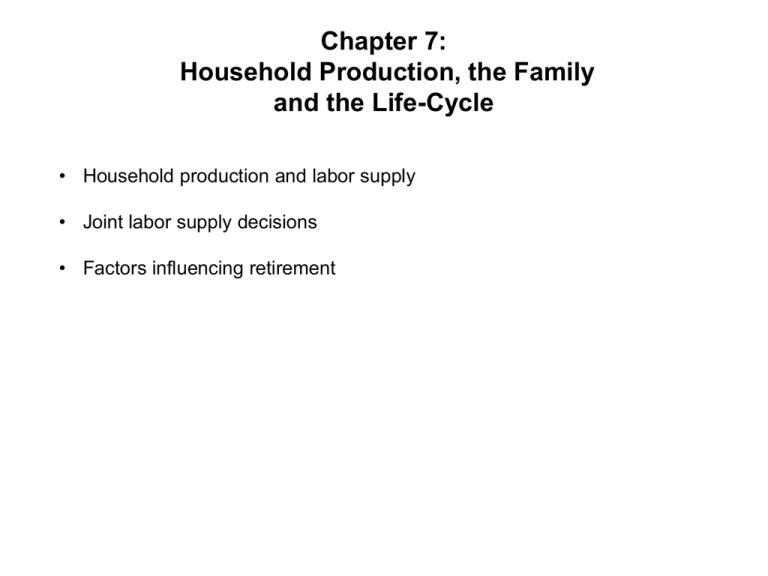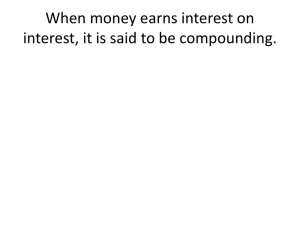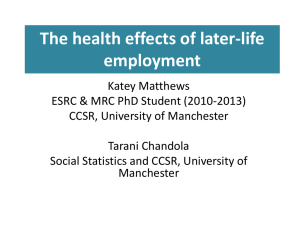Ch. 7: LIFE-CYCLE ASPECTS OF LABOR SUPPLY.
advertisement

Chapter 7: Household Production, the Family and the Life-Cycle • Household production and labor supply • Joint labor supply decisions • Factors influencing retirement Household production • Same as income vs leisure, except “leisure” can be used for household production • Household production can be cooking, cleaning, taking care of children, “leisure”, or anything that generates utility • Budget line is now a trade-off between “market goods” (income) and “home production”. Household production • When wage rate rises – Income effect: purchase more home-production (work less) – Substitution effect: • Purchase less home production (work more) • Adjust home production to more “goods intensive” and less “time intensive” – – – – Eat out more often & more processed foods (rising obesity?) More home technology More help hired for home production (cleaners, gardeners, daycare,…) Reduce quantity and increase “quality” of kids • Increased ability to substitute market goods for time will flatten indifference curves – increase work hours. Joint labor supply decisions • In a married household, if couple decides one will stay home to take care of children, what determines outcome? – Relative wages – Relative utility/ability in providing childcare • As womens wages rise relative to men’s, predicted effect on – Who stays home with children? – Division of time in home production? Joint labor supply decisions • During a recession, wage offers fall. • Offsetting effects on LFP – Discouraged worker effect – Added worker effect • Evidence is that discouraged worker effect dominates and LFP drops during recessions • Added worker effect has been shrinking due to – Increased UI generosity – More married women working • Choice of retirement age Choice of retirement age • Steepness of I-curve – reflects willingness to postpone retirement for additional income. • Steepness of budget constraint determined by – earnings profile – Social Security formula – pension plan features • Wealth and substitution effects from change in budget constratint. Choice of retirement age • If the financial rewards to postponing retirement beyond age 62 are increased, the person is faced with a wealth and substitution effect. • Wealth effect: Holding retirement age constant, the person has greater wealth and will retire sooner. • Substitution Effect: Holding wealth constant, the reward to postponing retirement has increased .. substitute money for years in retirement. • Net effect: Ambiguous. Choice of retirement age • Effect of increasing rewards to postponed retirement subst efffect > Wealth effect Wealth effect > subst efffect R* Choice of retirement age How do each of the following affect retirement age? • steepness of earnings profile? • Social Security formulae • Calculating AIME & PIA • reductions for early retirement • credits for postponed retirement. Choice of retirement age Private pensions •Defined benefit plan • life annuity promised at retirement. • annuity payment generally tied to years of service, final salary, and a "generosity factor". • PV of defined benefit plan may eventually fall with retirement age (fewer years to collect annuity versus increase in size of annuity). • “Actuarially fair” adjustment for postponing retirement by one year keeps PV of pension independent of retirement age. • If life expectancy is 80, what is actuarially fair adjustment for a worker who can collect an annuity of $50,000 annually at age 65, assuming interest rate=0? If interest rate>0? Choice of retirement age Private pensions •Defined Contribution Plan. •a savings account that the worker may receive as a lump sum at retirement. • PV of defined contribution plan grows with retirement age because contributions are added over time. • Over time, there has been a switch from defined benefit to defined contribution plans. • What's the effect of switching from DB to DC plans on retirement incentives?





